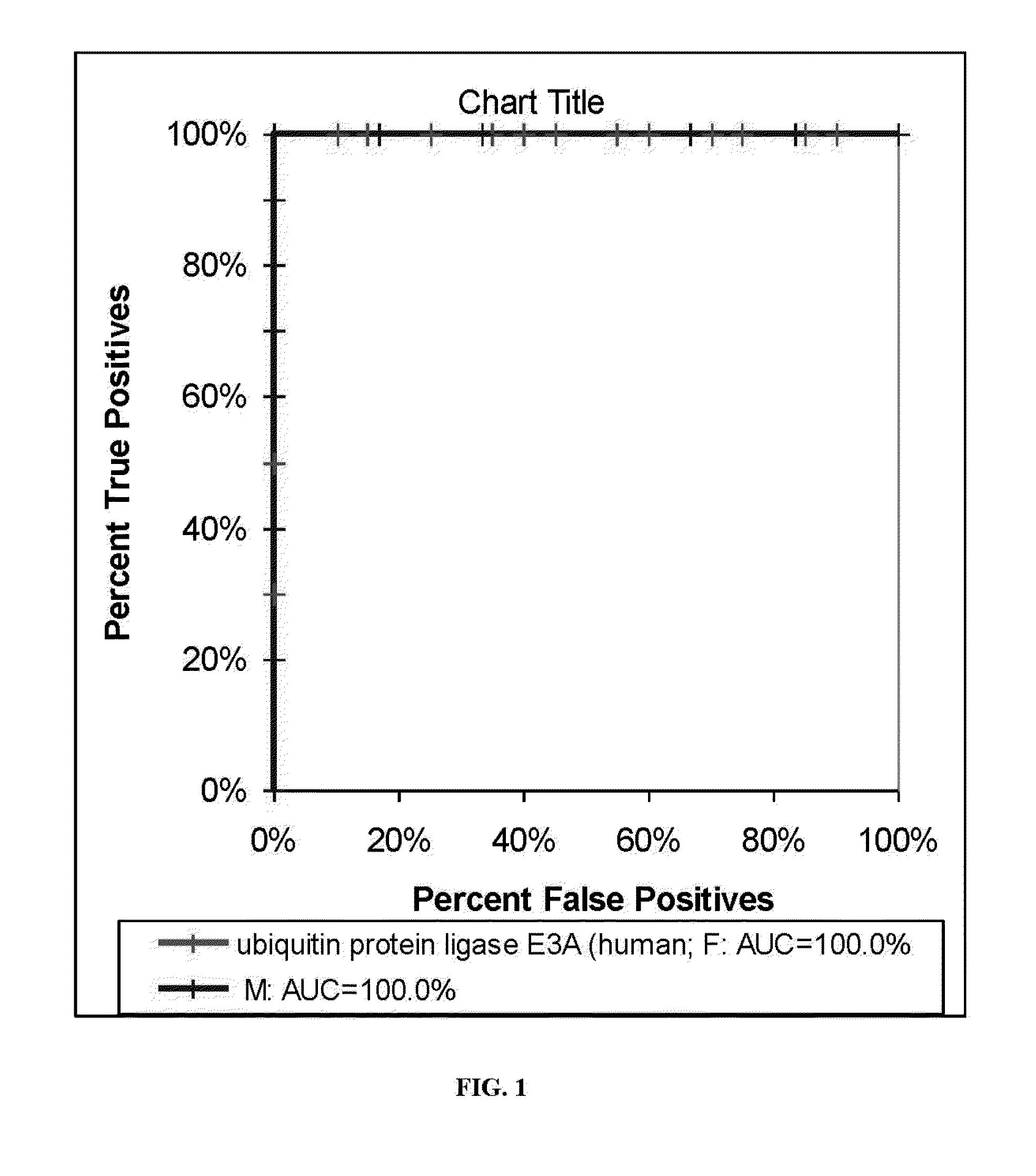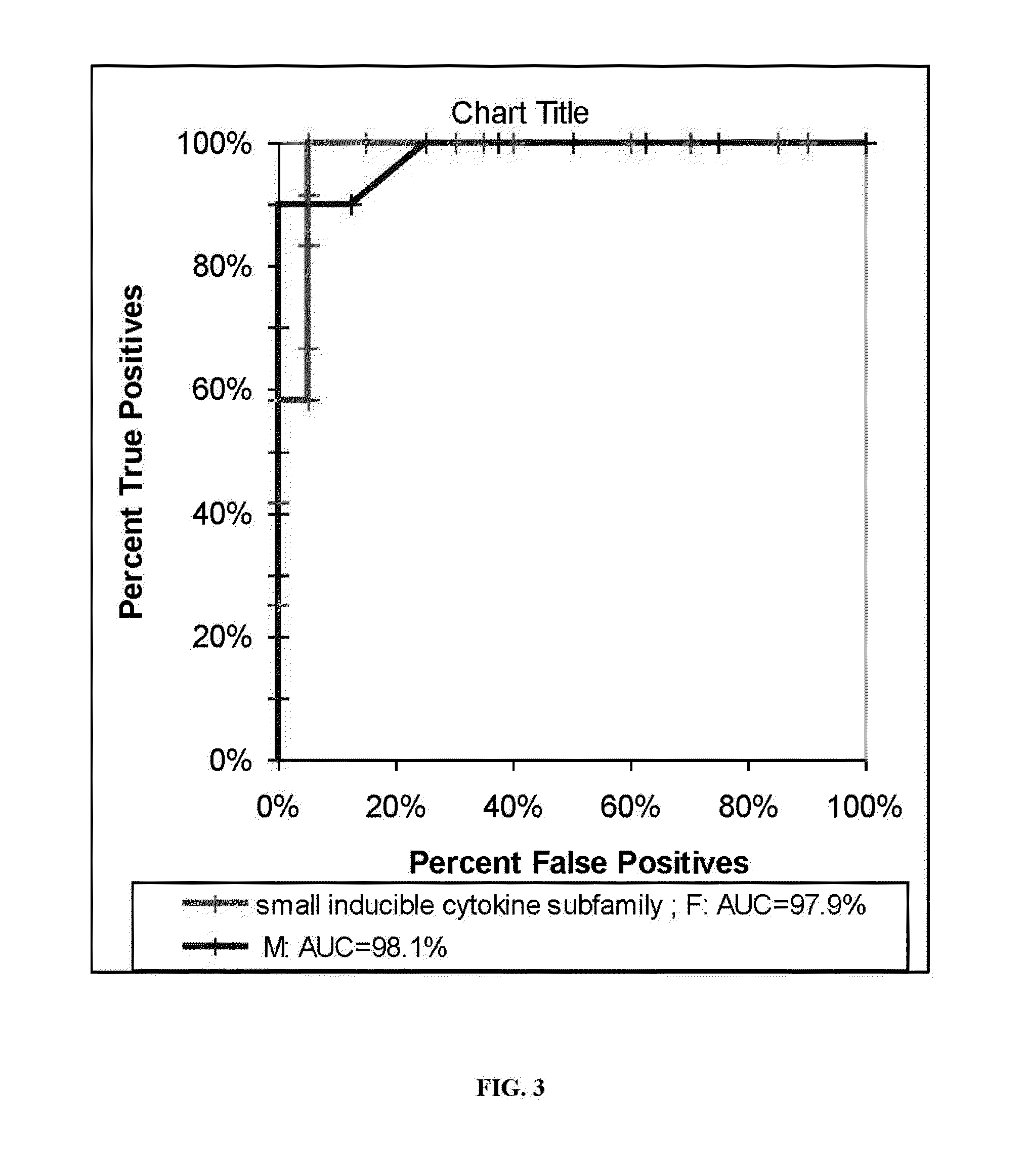Processes and kits to detect and monitor for diagnostic biomarkers for post traumatic stress disorder (PTSD) and to differentiate between suicidal and non-suicidal form of the disorder
a biomarker and post traumatic stress disorder technology, applied in the field of reliable detection and identification of markers, can solve the problems of ptsd often misdiagnosed, difficult to treat the severity of ptsd progression, and disrupt the quality of life of patients, their families and children, and achieve the effect of accurate aiding in the detection of suicide and/or ptsd
- Summary
- Abstract
- Description
- Claims
- Application Information
AI Technical Summary
Benefits of technology
Problems solved by technology
Method used
Image
Examples
example 1
[0099]Subjects with PTSD (n=13), BP (n=23), MDD (n=12), SCZ (n=12) and control (n=14) are diagnosed by two psychiatrists using criteria from The Diagnostic and Statistical Manual of Mental Disorders fourth edition DSM-IV. A biological sample of CSF, whole blood, plasma, serum, saliva and urine are obtained from each patient.
Patients
[0100]Fourteen medication-free outpatients with chronic civilian PTSD (34.9±10.4 years old, 10 women) and ten non-traumatized, healthy subjects (35.3±13.1 years old, 7 women) are selected. The healthy subjects are chosen to match PTSD patients as closely as possible with respect to age, sex and BMI. Prodromal PTSD Traumas are prepubertal in 5 subjects and adults in nine. Time elapsed from trauma exposure was 26±4 years in pre-pubertal trauma, and 10.1±8.8 years in adult exposure. Patients are otherwise physically healthy, with no psychotropic medication for at least three weeks prior to lumbar puncture and do not meet criteria for alcohol or substance abu...
example 2
[0110]Blood samples are obtained from twenty six (26) psychiatric patients with post-traumatic stress disorder (PTSD) and major depressive disorder (MDD), consisting of eleven (11) patients who attempted suicide, fifteen (15) patients whom do not exhibit suicidal behaviors and fourteen (14) normal controls who do not have PTSD. The subjects are not taking anti-psychotic medication. The samples are subsequently analyzed for mRNA of P-11 and mRNA of P2RX7 in peripheral blood mononuclear cells (PBMCs) using quantitative real-time PCR. A meta-analysis of microarray data of P-11, P2RX7 and S100β from post-mortem prefrontal cortex (PFC) of patients who committed suicide (n=56) and non-suicide controls (n=61) are also tested.
[0111]PBMC P-11 mRNA levels are significantly lower in suicide attempters and higher in suicide non-attempters, when compared to normal controls. The PFC P-11 mRNA levels in suicide completers are, also lower than non-suicide controls. Unlike P-11, P2RX7 mRNA levels ar...
example 3
[0119]The ability of the present invention to provide feedback as to the effectiveness of chemical and therapeutic agent interventions is provided in this example in which biological samples are obtained from a total of 49 subjects. Fourteen (14) of the subjects are determined to be suffering from PTSD, nine (9) of which are suicidal, the remaining five (5) are non-suicidal. Twenty one (21) of the subjects are determined to be suffering from BP, seven (7) of which are suicidal, the remaining fourteen (14) are non-suicidal. The remaining fourteen subjects are healthy control subjects. There are no significant group differences for gender (See Table 6). There are no statistically significant differences between BP or PTSD patients and control subjects in terms of age, gender ratio, education level or marital status. Table 6 shows that BP and PTSD patients, with and without suicide attempts, have similar average ages at onset, respectively.
[0120]All PTSD subjects are medicated with six...
PUM
| Property | Measurement | Unit |
|---|---|---|
| Atomic weight | aaaaa | aaaaa |
| Atomic weight | aaaaa | aaaaa |
| Atomic weight | aaaaa | aaaaa |
Abstract
Description
Claims
Application Information
 Login to View More
Login to View More - R&D
- Intellectual Property
- Life Sciences
- Materials
- Tech Scout
- Unparalleled Data Quality
- Higher Quality Content
- 60% Fewer Hallucinations
Browse by: Latest US Patents, China's latest patents, Technical Efficacy Thesaurus, Application Domain, Technology Topic, Popular Technical Reports.
© 2025 PatSnap. All rights reserved.Legal|Privacy policy|Modern Slavery Act Transparency Statement|Sitemap|About US| Contact US: help@patsnap.com



